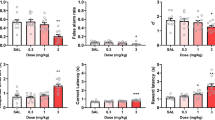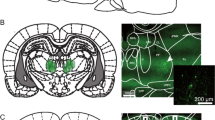Abstract
Rationale
The ability to detect unpredictable cues can involve stimulus-elicited orienting of attention (bottom-up processing); however, in many settings, target onset is partially predictable, meaning that subjects can benefit from the rule-guided, endogenous control of attention (top-down processing). Noradrenaline has been implicated in attention per se, but it is not clear whether it differentially participates in these two dimensions of attentional function.
Objectives
We sought to examine the effects of selective or nonselective inhibitors of noradrenaline reuptake on different modes of attentional performance in rats.
Materials and methods
Adult male Long–Evans rats were trained to perform a lateralized reaction time task where a variable-duration preparatory period preceded delivery of a visual target stimulus. Atomoxetine (1 mg/kg, i.p.) or methylphenidate (0.32 mg/kg, i.p.) were administered before sessions in which the preparatory period was systematically varied.
Results
When the preparatory time was brief (0.2 s), response times were significantly longer than when the preparatory time was long (1.0 s), suggesting that rats were able to orient their attention before target onset when the longer period was imposed. Atomoxetine differentially modulated performance in these two conditions, improving response accuracy when a long preparatory period was imposed but impairing accuracy when the preparatory time was made brief. Methylphenidate did not differentially affect responding under the two conditions.
Conclusions
These data suggest that selective inhibition of the noradrenaline transporter may specifically benefit attentional performance of tasks that permit the controlled recruitment of attention, rather than during tests of pure stimulus-driven attention.


Similar content being viewed by others
References
Aston-Jones G, Rajkowski J, Cohen J (2000) Locus coeruleus and regulation of behavioral flexibility and attention. Prog Brain Res 126:165–182
Berridge CW, Waterhouse BD (2003) The locus coeruleus-noradrenergic system: modulation of behavioral state and state-dependent cognitive processes. Brain Res Brain Res Rev 42:33–84
Berridge CW, Devilbiss DM, Andrzejewski ME, Arnsten AF, Kelley AE, Schmeichel B, Hamilton C, Spencer RC (2006) Methylphenidate preferentially increases catecholamine neurotransmission within the prefrontal cortex at low doses that enhance cognitive function. Biol Psychiatry 60:1111–1120
Blondeau C, Dellu-Hagedorn F (2007) Dimensional analysis of ADHD subtypes in rats. Biol Psychiatry 61:1340–1350
Brasted PJ, Dunnett SB, Robbins TW (2000) Unilateral lesions of the medial agranular cortex impair responding on a lateralised reaction time task. Behav Brain Res 111:139–151
Brown VJ, Robbins TW (1989) Deficits in response space following unilateral striatal dopamine depletion in the rat. J Neurosci 9:983–989
Brown VJ, Bowman EM, Robbins TW (1991) Response-related deficits following unilateral lesions of the medial agranular cortex of the rat. Behav Neurosci 105:567–578
Carli M, Robbins TW, Evenden JL, Everitt BJ (1983) Effects of lesions to ascending noradrenergic neurones on performance of a 5-choice serial reaction task in rats; implications for theories of dorsal noradrenergic bundle function based on selective attention and arousal. Behav Brain Res 9:361–380
Carli M, Evenden JL, Robbins TW (1985) Depletion of unilateral striatal dopamine impairs initiation of contralateral actions and not sensory attention. Nature 313:679–682
Cole BJ, Robbins TW (1992) Forebrain norepinephrine: role in controlled information processing in the rat. Neuropsychopharmacology 7:129–142
Connor CE, Egeth HE, Yantis S (2004) Visual attention: bottom-up versus top-down. Curr Biol 14:R850–R852
Corbetta M, Shulman GL (2002) Control of goal-directed and stimulus-driven attention in the brain. Nat Rev Neurosci 3:201–215
Dalley JW, McGaughy J, O’Connell MT, Cardinal RN, Levita L, Robbins TW (2001) Distinct changes in cortical acetylcholine and noradrenaline efflux during contingent and noncontingent performance of a visual attentional task. J Neurosci 21:4908–4914
Dalley JW, Theobald DE, Eagle DM, Passetti F, Robbins TW (2002) Deficits in impulse control associated with tonically-elevated serotonergic function in rat prefrontal cortex. Neuropsychopharmacology 26:716–728
Dalley JW, Cardinal RN, Robbins TW (2004) Prefrontal executive and cognitive functions in rodents. Neurosci Biobehav Rev 28:771–784
Dalley JW, Fryer TD, Brichard L, Robinson ES, Theobald DE, Laane K, Pena Y, Murphy ER, Shah Y, Probst K, Abakumova I, Aigbirhio FI, Richards HK, Hong Y, Baron JC, Everitt BJ, Robbins TW (2007) Nucleus accumbens D2/3 receptors predict trait impulsivity and cocaine reinforcement. Science 315:1267–1270
Deco G, Rolls ET (2005) Attention, short-term memory, and action selection: a unifying theory. Prog Neurobiol 76:236–256
Eagle DM, Tufft MR, Goodchild HL, Robbins TW (2007) Differential effects of modafinil and methylphenidate on stop-signal reaction time task performance in the rat, and interactions with the dopamine receptor antagonist cis-flupenthixol. Psychopharmacology (Berl) 192:193–206
Harrison AA, Everitt BJ, Robbins TW (1997) Central 5-HT depletion enhances impulsive responding without affecting the accuracy of attentional performance: interactions with dopaminergic mechanisms. Psychopharmacology (Berl) 133:329–342
Jentsch JD, Arguello PA, Anzivino LA (2003) Null mutation of the arginine-vasopressin gene in rats slows attentional engagement and facilitates response accuracy in a lateralized reaction time task. Neuropsychopharmacology 28:1597–1605
Miller EK, Cohen JD (2001) An integrative theory of prefrontal cortex function. Annu Rev Neurosci 24:167–202
Milstein JA, Lehmann O, Theobald DE, Dalley JW, Robbins TW (2007) Selective depletion of cortical noradrenaline by anti-dopamine beta-hydroxylase-saporin impairs attentional function and enhances the effects of guanfacine in the rat. Psychopharmacology (Berl) 190:51–63
Navarra R, Graf R, Huang Y, Logue S, Comery T, Hughes Z, Day M (2007) Effects of atomoxetine and methylphenidate on attention and impulsivity in the 5-choice serial reaction time test. Prog Neuropsychopharmacol Biol Psychiatry 32(1):34–41
Puumala T, Ruotsalainen S, Jakala P, Koivisto E, Riekkinen P Jr, Sirvio J (1996) Behavioral and pharmacological studies on the validation of a new animal model for attention deficit hyperactivity disorder. Neurobiol Learn Mem 66:198–211
Robbins TW (1997) Arousal systems and attentional processes. Biol Psychol 45:57–71
Robinson ES, Eagle DM, Mar AC, Bari A, Banerjee G, Jiang X, Dalley JW, Robbins TW (2007) Similar effects of the selective noradrenaline reuptake inhibitor atomoxetine on three distinct forms of impulsivity in the rat. Neuropsychopharmacology 33(5):1028–1037
Usher M, Cohen JD, Servan-Schreiber D, Rajkowski J, Aston-Jones G (1999) The role of locus coeruleus in the regulation of cognitive performance. Science 283:549–554
Witte EA, Marrocco RT (1997) Alteration of brain noradrenergic activity in rhesus monkeys affects the alerting component of covert orienting. Psychopharmacology (Berl) 132:315–323
Acknowledgement
These experiments were funded, in part, by PHS grants P50-MH77248 and P20-DA22539 to JDJ and a grant from the Tenenbaum Creativity Initiative at UCLA.
Conflicts of interest statement
The authors have no competing conflicts of interest.
Author information
Authors and Affiliations
Corresponding author
Rights and permissions
About this article
Cite this article
Jentsch, J.D., Aarde, S.M. & Seu, E. Effects of atomoxetine and methylphenidate on performance of a lateralized reaction time task in rats. Psychopharmacology 202, 497–504 (2009). https://doi.org/10.1007/s00213-008-1181-0
Received:
Accepted:
Published:
Issue Date:
DOI: https://doi.org/10.1007/s00213-008-1181-0




